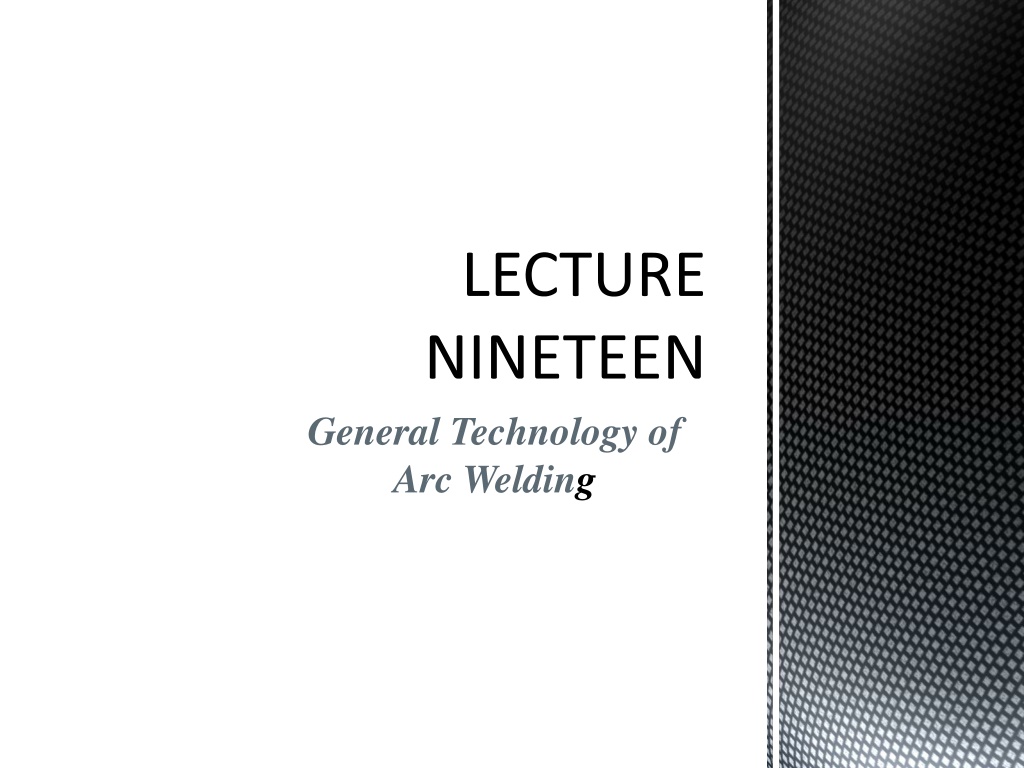Essential Information on Arc Welding Technology
Arc welding is a fusion process utilizing an electric arc to melt metals for joining. Consumable and nonconsumable electrodes play key roles, providing filler metal and resisting arc heat respectively. Arc shielding using gases or flux prevents metal contamination. Understanding these fundamental concepts is crucial for successful arc welding operations.
Download Presentation

Please find below an Image/Link to download the presentation.
The content on the website is provided AS IS for your information and personal use only. It may not be sold, licensed, or shared on other websites without obtaining consent from the author.If you encounter any issues during the download, it is possible that the publisher has removed the file from their server.
You are allowed to download the files provided on this website for personal or commercial use, subject to the condition that they are used lawfully. All files are the property of their respective owners.
The content on the website is provided AS IS for your information and personal use only. It may not be sold, licensed, or shared on other websites without obtaining consent from the author.
E N D
Presentation Transcript
LECTURE NINETEEN General Technology of Arc Welding
Introduction Arc welding (AW) is a fusion-welding process in which coalescence of the metals is achieved by the heat of an electric arc between an electrode and the work. An electric arc is a discharge of electric current across a gap in a circuit. To initiate the arc in an AW process, the electrode is brought into contact with the work and then quickly separated from it by a short distance. The electric energy from the arc thus formed produces temperatures of 5500C (10,000F) or higher, sufficiently hot to melt any metal. A pool of molten metal, consisting of base metal(s) and filler metal (if one is used) is formed near the tip of the electrode. In most arc welding processes, filler metal is added during the operation to increase the volume and strength of the weld joint. Before describing the individual AW processes, it is instructional to examine some of the general technical issues that apply to these processes.
Electrodes Electrodes used inAW processes are classified as consumable or nonconsumable. Consumable electrodes provide the source of the filler metal in arc welding. These electrodes are available in two principal forms: rods (also called sticks) and wire. The problem with consumable welding rods, at least in production welding operations, is that they must be changed periodically. Consumable weld wire has the advantage that it can be continuously fed into the weld pool from spools containing long lengths of wire, thus avoiding the frequent interruptions that occur when using welding sticks. In both rod and wire forms, the electrode is consumed by the arc during the welding process and added to the weld joint as filler metal.
Nonconsumable electrodes are made of tungsten (or carbon, rarely), which resists melting by the arc. Despite its name, a nonconsumable electrode is gradually depleted during the welding process (vaporization is the principal mechanism), analogous to the gradual wearing of a cutting tool in a machining operation. For AW processes that utilize nonconsumable electrodes, any filler metal used in the operation must be supplied by means of a separate wire that is fed into the weld pool.
Arc shielding: At the high temperatures in arc welding, the metals being joined are chemically reactive to oxygen, nitrogen, and hydrogen in the air. The mechanical properties of the weld joint can be seriously degraded by these reactions. Thus, some means to shield the arc from the surrounding air is provided in nearly all AW processes. Arc shielding is accomplished by covering the electrode tip, arc, and molten weld pool with a blanket of gas or flux, or both, . Common shielding gases include argon and helium, both of which are inert. Aflux is a substance used to prevent the formation of oxides and other unwanted contaminants, or to dissolve them and facilitate removal. During welding, the flux melts and becomes a liquid slag, covering the operation and protecting the molten weld metal
The slag hardens upon cooling and must be removed later by chipping or brushing. Flux is usually formulated to serve several additional functions: (1) Provide a protective atmosphere for welding. (2) Stabilize the arc. (3) Reduce spattering. The method of flux application differs for each process. The delivery techniques include: (1) Pouring granular flux onto the welding operation. (2) Using a stick electrode coated with flux material in which the coating melts during welding to cover the operation. (3) Using tubular electrodes in which flux is contained in the core and released as the electrode is consumed
Power Source inArc Welding: Both direct current (DC) and alternating current (AC) are used in arc welding. AC machines are less expensive to purchase and operate, but are generally restricted to welding of ferrous metals. DC equipment can be used on all metals with good results and is generally noted for better arc control. In all arc-welding processes, power to drive the operation is the product of the current I passing through the arc and the voltage E across it. This power is converted into heat, but not all of the heat is transferred to the surface of the work. Convection, conduction, radiation, and spatter account for losses that reduce the amount of usable heat.
Example: A gas tungsten arc-welding operation is performed at a current of 300A ,and voltage of 20V. The melting factor f2= 0.5, and the unit melting energy for the metal Um = 10 J/mm3. Determine (a) power in the operation, (b) rate of heat generation at the weld, and (c) volume rate of metal welded. Solution: (a) The power in this arc-welding operation is























